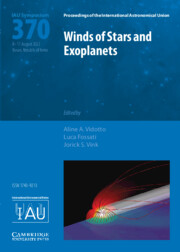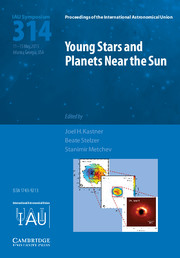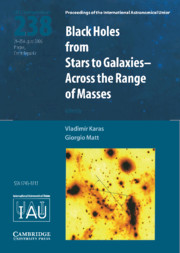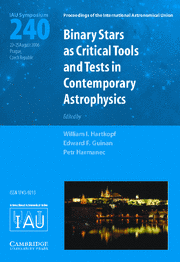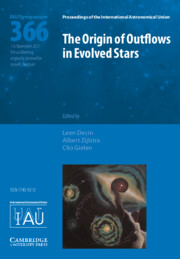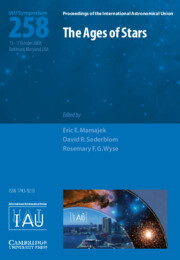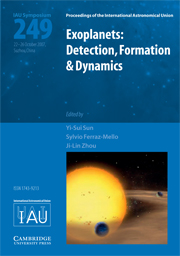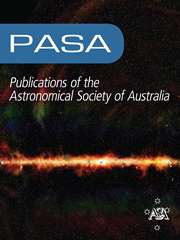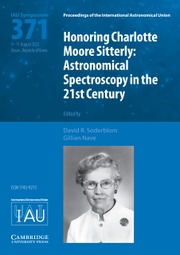Winds of Stars and Exoplanets (IAU S370)
Part of Proceedings of the International Astronomical Union Symposia and Colloquia
- Editors:
- Aline Vidotto, Leiden Observatory, The Netherlands
- Luca Fossati, Space Research Institute, Austrian Academy of Sciences, Graz
- Jorick Vink, Armagh Observatory and Planetarium
- Date Published: September 2023
- availability: In stock
- format: Hardback
- isbn: 9781009352789
Hardback
Looking for an inspection copy?
This title is not currently available on inspection
-
Winds form an integral part of astronomy – from regulating rotation of stars through enriching galaxies with fresh materials. Outflowing winds persist during the entire lives of stars and play a key role in shaping the exoplanet demographics we observe. In massive stars, their winds are a vital ingredient of their evolution, from the main sequence to the pre-supernova stage, determining black hole masses as measured from gravitational waves. In the case of low-mass stars, their winds dictate rotational evolution, which affect angular momentum distribution within the stellar interior and thus the generation of magnetic fields. In the case of planets, winds take the form of atmospheric escape, which can strongly affect their atmospheric evolution. IAU Symposium 370 brings together researchers on winds of exoplanets and stars, including the solar wind, to share insights into the physics and modelling tools used by these different communities.
Read more- Dedicated winds symposium features research on winds of close-in exoplanets (atmospheric escape), winds of low- and high-mass stars and the solar wind
- Gives a broad insight into the work of different research communities
- Part of the IAU's XXXIst General Assembly held in Busan, Korea, in August 2022
Reviews & endorsements
'The very diverse strands are, however, brought together in a comprehensive, magisterial survey by Stan Owocki of the physical processes driving the outflows from stars and planets - ranging from the CAK formalism of the line-driven winds of massive stars, through the solar corona and wind, spin-down, planetary winds and mass loss, followed by a discussion of magnetospheres of stars and planets. The proceedings continue with a section on observational evidence for winds, led by reviews on low-mass stars, high-mass stars, and planets … Conference proceedings containing reviews and short communications giving a snapshot of current work are often suggested as a good means for beginners to get started in a new field; the present volume gives entry to three.' Peredur Williams, The Observatory
Customer reviews
Not yet reviewed
Be the first to review
Review was not posted due to profanity
×Product details
- Date Published: September 2023
- format: Hardback
- isbn: 9781009352789
- length: 300 pages
- dimensions: 253 x 179 x 16 mm
- weight: 0.63kg
- availability: In stock
Table of Contents
Part I. Overview of winds of stars and exoplanets:
1. Winds and magnetospheres from stars and planets: similarities and differences
2. Observations of winds and CMEs of low-mass stars
3. Observations of outflows of massive stars
Part II. Observational evidence of winds:
4. Observations of planetary winds and outflows
5. The effect of winds in red supergiants: modeling for interferometry
6. The porous envelope and circumstellar wind matter of the closest carbon star, CW Leonis
7. Is the magnetospheric accretion active in the Herbig Ae/Be stars?
8. Short-term variations of surface magnetism and prominences of the young sun-like star V530 Per
9. Water and silicon-monoxide masers monitored towards the 'water fountain' sources
10. Weakening the wind with ULLYSES: Examining the Bi-stability jump
11. Statistical properties of cold circumstellar envelops observed in NESS-NRO
12. The origin of planetary winds
13. Stellar wind from low-mass main-sequence stars: an overview of theoretical models
14. The driving of hot star winds
15. Slingshot prominences, formation, ejection and cycle frequency in cool stars
Part III. Physical ingredients of winds:
16. Effect of stellar flares and coronal mass ejections on the atmospheric escape from hot Jupiters
17. Physics of the atmospheric escape driven by EUV photoionization heating: Classification of the hydrodynamic escape in close-in planets
18. Discrete absorption components from 3-D spot models of hot star winds
19. Hydrodynamic disk solutions for Be stars using HDUST
20. Role of longitudinal waves in Alfvén-wave-driven solar/stellar wind
21. ISOSCELES Grid of stellar atmosphere and hydrodynamic models of massive stars: The first results
22. Quantification of the environment of cool stars using numerical simulations
23. Hydrodynamic solutions of radiation driven wind from hot stars
24. Gap opening by planets in discs with magnetised winds
25. Solar wind and hydrologic cycle
26. Magnetic confinement in the wind of low mass stars
27. Clumping and X-rays in cool B supergiants
28. Interaction between massive star winds and the interstellar medium
29. Numerical modeling of galactic superwinds with time-evolving stellar feedback
Part IV. Flow-flow interactions:
30. Winds of OB stars: impact of metallicity, rotation and binary interaction
31. X-ray view of colliding winds in WR 25
32. Double tail structure in escaping atmospheres of magnetised close-in giant planets
33. Shock breakout in winds of red supergiants: Type IIP supernovae
34. On the making of a PN: the interaction of a multiple stellar wind with the ISM
35. Role of planetary winds in planet evolution and population
36. Size evolution and orbital architecture of KEPLER small planets through giant impacts and photoevaporation
Part V. Relevance of winds on stellar/planetary evolution:
37. Spin-down and reduced mass loss in early-type stars with large-scale magnetic fields
38. Mass loss implementation and temperature evolution of very massive stars
39. The evolution of atmospheric escape of highly irradiated gassy exoplanets
40. The future of Jupiter-like planets around Sun-like stars: first steps
41. Rapid orbital precession of the eclipsing binary HS Hydrae
42. To the dynamics of the two-body problem with variable masses in the presence of reactive forces
43
Evolution equations of the multi-planetary problem with variable masses
44. Planet migration in accretion discs in binary systems
45. Signatures of wind formation in optical spectra of precursors of planetary nebulae.
Sorry, this resource is locked
Please register or sign in to request access. If you are having problems accessing these resources please email [email protected]
Register Sign in» Proceed
You are now leaving the Cambridge University Press website. Your eBook purchase and download will be completed by our partner www.ebooks.com. Please see the permission section of the www.ebooks.com catalogue page for details of the print & copy limits on our eBooks.
Continue ×Are you sure you want to delete your account?
This cannot be undone.
Thank you for your feedback which will help us improve our service.
If you requested a response, we will make sure to get back to you shortly.
×
